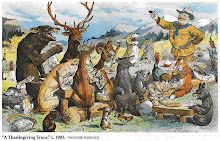Elk Reproduction Improved With Mature Bulls
By David Hewitt - Boone and Crockett Club Professional MemberLarge, mature animals are symbols of excellent habitat and sound wildlife management. They are also indicative of a natural age structure that fosters normal reproduction and thus a productive population. So suggests research in Oregon that demonstrates mature bull elk are valuable to the reproductive health of elk herds.
Scientists from the Oregon Department of Fish and Wildlife and the United States Forest Service studied an enclosed elk herd in a research area of nearly 20,000 acres. The objective was to investigate the effect of bull age on pregnancy rates and breeding dates of cow elk. During two successive five-year periods, about 400 cow elk were exposed to a cohort of bulls that began each period as yearlings and ended as 5 year-olds. About 30 cow elk were harvested each December, enabling scientists to determine if each cow was pregnant and the date she was bred.The proportion of female elk that were pregnant was high in all years, showing that bulls of any age can successfully breed. The authors noted, however, that in the two years in which yearling bulls were breeding, nutritional conditions were exceptionally good, and it is possible that with average or poor conditions, yearling bulls may not have been as effective.
Conception date was strongly influenced by the age of breeding bulls. Average conception dates were 2 weeks earlier when breeding was done by five year-old bulls compared to yearling bulls. The first conceptions occurred in early September, regardless of bull age, but most breeding was completed around October 1 when five-year old bulls were breeding, but not until late October when yearling bulls were breeding.
What do these results mean? Mature bulls appear to be more efficient breeders than young bulls, which has several implications.
- Shorter breeding periods mean that most calves are born about the same time. Many prey species rely on synchronous births to swamp predators and thus reduce the effect of predation on survival of young.
- Earlier conception results in earlier birth dates, thereby providing calves more time to grow before winter. The additional growth may increase their survival during winter.
- Breeding can be stressful to male elk and potentially lower their survival. Young males may be especially susceptible because they typically are in poorer condition coming into the rut than mature males. When there are mature males in the herd, young males may not even try to breed, which enables them to maintain their body condition and improves their survival. High survival of young males means more mature, large males in future years.
- Presence of trophy class bull elk is indicative of management that promotes a natural age structure, resulting in breeding patterns that are beneficial to the elk population.
The study on which this edition of Trophy Points is based is described in:
J. H. Noyes, B. K. Johnson, B. L. Dick, J. G. Kie. 2002. Effects of Male Age and Female Nutritional Condition on Elk Reproduction. Journal of Wildlife Management 66:1301-1307.J. H. Noyes, B. K. Johnson, L. D. Bryant, S. L. Findholt, J. W. Thomas. 1996. Effects of Bull Age on Conception Dates and Pregnancy Rates of Cow Elk. Journal of Wildlife Management 60:508-517.










No comments:
Post a Comment